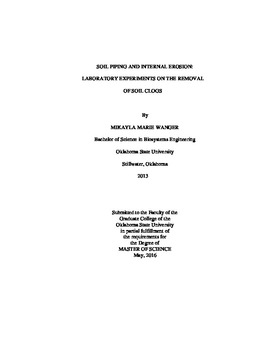| dc.contributor.advisor | Fox, Garey A. | |
| dc.contributor.author | Wanger, Mikayla Marie | |
| dc.date.accessioned | 2017-02-22T22:16:52Z | |
| dc.date.available | 2017-02-22T22:16:52Z | |
| dc.date.issued | 2016-05-01 | |
| dc.identifier.uri | https://hdl.handle.net/11244/49179 | |
| dc.description.abstract | Clogging of soil pipes can be detrimental to hillslope stability leading to landscape failures. A soil pipe becomes clogged through internal erosion or pipe collapse; therefore, it is important to obtain more information surrounding these clogging occurrences in order to better predict their effects. When a pipe becomes clogged, a pressure buildup occurs upstream from the clog. This pressure may be enough to remove the clog, or the pressure may continue to build in the soil matrix which could lead to landscape failures. Field observations have indicated occurrences of both, and this study investigated characteristics for which the clog was removed or remained intact. Laboratory experiments were conducted with a 100 cm long clear polyvinyl chloride pipe. A pipe clog was established 90 cm along the pipe length. Triplicate experiments were conducted with two pipe diameters, two soil types (sand and sandy loam), two clog lengths, three pipe roughness, various packing densities, and with both dynamic and constant heads. Digital pressure gauges were installed along the second half of the pipe to monitor pressures both before and after the clog. The upstream pressure and the length of time that the plug withstood the pressure before removal were recorded. Regardless of pressurized time, all clogs were removed as plugs. Adding pipe roughness increased the removal time for the sandy clay loam soil by more than 50%, but had no effect on the sand plugs. The relationship between applied head and pressurized time was a negative exponential relationship. The bulk density had a positive exponential relationship to the pressurized time. In field situations, the hydrology of the water inside of the clog will need to be considered for a model. Data obtained through the experiments outlined above will assist model developers in creating a model for soil piping and internal erosion. This will allow researchers to better understand and predict internal erosion, eventually leading to the ability to prevent major landscape failures. | |
| dc.format | application/pdf | |
| dc.language | en_US | |
| dc.rights | Copyright is held by the author who has granted the Oklahoma State University Library the non-exclusive right to share this material in its institutional repository. Contact Digital Library Services at lib-dls@okstate.edu or 405-744-9161 for the permission policy on the use, reproduction or distribution of this material. | |
| dc.title | Soil Piping and Internal Erosion: Laboratory Experiments on the Removal of Soil Clogs | |
| dc.contributor.committeeMember | Ochsner, Tyson E. | |
| dc.contributor.committeeMember | Storm, Daniel E | |
| osu.filename | Wanger_okstate_0664M_14529.pdf | |
| osu.accesstype | Open Access | |
| dc.description.department | Biosystems & Agricultural Engineering | |
| dc.type.genre | Thesis | |
| dc.type.material | text | |
